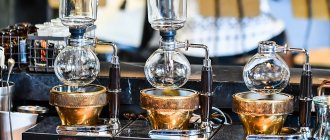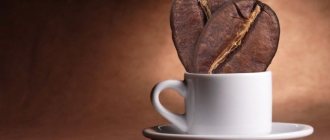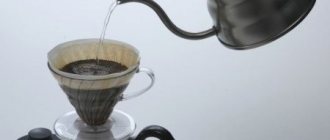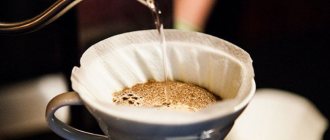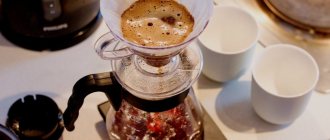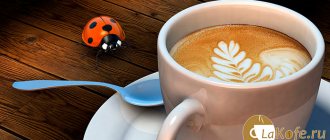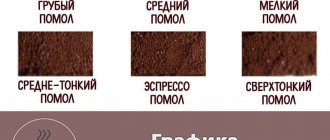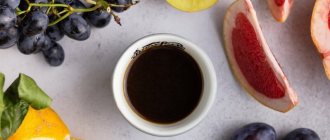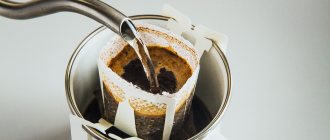Creating a coffee extract is an art where everyone is the creator of a unique work, and in our case, the work is a coffee “cup”. Grind size, brewing method, equipment - these are all just tools that work for your taste buds and preferences.
Coffee as a drink is an extract. Popular brewing methods—espresso and alternative—where water in one form or another passes through the coffee, taking the flavor and aroma with it. Whether it is the deep taste of a dark roast or the fruity and floral notes of a light roast - the choice is always yours, you have a huge range of possibilities.
The most common methods of preparing coffee include:
Preparing coffee in an espresso machine
Coffee in an espresso machine is prepared using "brute force" - water is forced through the grinder under high pressure, which stimulates a high extraction rate. Most machines perform this action without human intervention, but higher-end espresso machines allow you to adjust the temperature, pressure, and time. This is useful for achieving perfect extraction because beans from different regions have different levels of hardness, and, of course, degree of roast.
All these are extraction factors. The ideal formula for espresso is a simple equation: the weight of the bean is multiplied by 1.8 to get the weight of the finished drink. That is, 20 * 1.8 is 36 grams of black coffee in a cup. The extraction time is from 20 to 30 seconds. The settings also vary by the amount of grain and, of course, grinding.
gram, creative under - and you are a real barista
To prevent the morning rush from turning into spilled coffee, the C807 station automatically doses and tamps exactly 22 grams of coffee. This precision will ensure that every cup is consistently harmonious and delicious, whether it’s your first espresso or your thousandth. Those who prefer their coffee with foam can choose from nine texture options to create the perfect foam consistency for a cappuccino or latte, and 35 temperature settings will help prevent the liquid from overheating.
Even a teenager can prepare their favorite drink - the touch display of the BORK C807 coffee station offers six of the most popular drinks: latte, cappuccino, flat white, espresso, Americano and just hot milk. For creative users, there is an option to add your own recipes. Once you have taught the C807 to prepare coffee at a low temperature and with cream instead of milk, the next time you can start brewing with one touch.
Especially for those who want to diversify their morning coffee routine with the help of a BORK coffee maker, barista experts offer simple recipes that will definitely not leave you indifferent. Try it!
Making coffee in a pour over/Chemex
The authentic taste of medium and light roast coffee is best enjoyed with a ceramic, glass or plastic brewer that can hold a paper filter and brew multiple servings of coffee. This method is professional and ensures the best disclosure of the flavor and aroma properties of the coffee extract.
- Use ground coffee or grind whole beans to a medium to medium coarse grind size .
- Prepare approximately 20 to 30 grams (or 1 to 1.5 tablespoons) of coffee per 1 cup (340 g) of water; depending on the desired taste and strength.
- Let the water boil and wait a couple of minutes. If you have a thermometer, measure the water temperature until it reaches 94 degrees Celsius.
- Pour some water - a couple of tablespoons (40 grams) into a filter or cone and observe the degassing process.
- After 30-45 seconds, slowly pour in the water until it is evenly mixed into the grinds.
- Wait until the coffee has completely drained into the cup.
- Enjoy!
How to use homemade coffee scrub correctly
To enhance the effect of the scrub, use a brush for dry lymphatic drainage massage. After the massage, it is necessary to moisturize and steam the skin; this is best done in a bathhouse. Next, apply the scrub to damp, steamed skin with massage movements, starting from the feet and moving up. Make sure that no water gets into the jar with the scrub, so it is better to scoop the scrub with a spoon.
Leave the scrub on the skin for a while so that the beneficial components are absorbed and take effect. Then rinse with warm water. If necessary, use whipped butter or body moisturizer.
Huge request! Don't use coffee scrub on your face!
Preparing coffee in a French press
The basis of coffee preparation is the brewing method, which includes completely immersing ground coffee in water, infusing and then filtering the finished drink.
- Use ground coffee or grind whole beans to a medium to coarse grind size .
- Prepare approximately 20 to 30 grams (or 1 to 1.5 tablespoons) of coffee per 1 cup (340 g) of water; depending on the desired taste and strength.
- Let the water boil and wait a couple of minutes. If you have a thermometer, measure the water temperature until it reaches 94 degrees Celsius.
- While the water is boiling, rinse the French press with hot water; press the plunger up and down several times, then pull up, remove the cap and drain the water.
- Pour ground coffee into French press; stir until the grounds are evenly distributed across the bottom.
- Pour about half the hot water over the grounds evenly and wait about 30 seconds. You should see the coffee rise slightly as water seeps into it (also known as "degassing"). Timing this step is important to properly release all the aromas and flavors of your coffee.
- After about 30 seconds or when the coffee stops expanding, stir the coffee gently.
- Pour the remaining water into the French press, pull the plunger up and close the lid. Let the coffee sit for another 3.25 to 3.5 minutes (4 minutes total from the initial pour).
- After 4 minutes, slowly push the plunger all the way down to filter out the coffee grounds. Serve the coffee immediately afterwards. Do not leave coffee in the French press as it will become bitter.
Piston method
One of the simplest methods of making coffee is to use a piston coffee maker without the help of electricity or special mechanisms, otherwise called a French press. This is a narrow, tall glass vessel with a piston attached to the lid. The process of making a drink using this method begins with heating the vessel. Then coarsely ground coffee beans are poured onto its bottom, after which they are filled with heated water. After three to five minutes, the liquid is separated from the grounds using a piston. This method makes it possible to ensure maximum extraction of flavor from the ground beans. Its only drawback is that the French press is not able to retain heat for a long time, so the finished drink must be drunk immediately.
Making coffee in a drip coffee machine
Drip coffee machines have come a long way since their invention in the 1950s—many have automatic water dispensing that simulates manual pouring. Be sure to clean the dripper periodically (every 3-6 months) with descaling tablets.
- Use ground coffee or grind whole beans to a medium or medium-fine grind .
- Prepare approximately 20-30 grams of coffee per 1 cup (340 g) of water; depending on the desired taste and strength.
- Place the ground coffee into the filter.
- Pour in the amount of water that matches the amount of coffee you put in the filter.
- Please refer to the included coffee maker instructions to learn more about the details of setting up the machine.
- Wait for the coffee to fully brew and drain into the carafe (a cup poured mid-brew will not have a balanced flavor).
Rating of the best
There are a large number of cosmetic brands from different manufacturers on the market. Many of them produce scrubbing products, peelings and masks, because... these products are in great demand. The main brands that can be found in stores:
- Riche;
- "Coffee-original";
- Organic Shop;
- "Aromania";
- Body spa;
- Savonry;
- Ecolab;
- Sweet fresh.
Riche
This company is one of those that is well known. It produces a large number of cosmetics, incl. and coffee scrubs. The product line is quite wide, which allows you to find the right product. Anti-cellulite compositions contain large abrasive particles. The structure of such products is crumbly and dry. The tonic composition contains tangerine, and the moisturizing composition contains chocolate.
Riche produces coffee scrubs.
In addition, this company offers customers a harsher scrub for men. The cost of a 250 g package is about 1,500 rubles.
"Coffee-original"
This is a budget line of products, but their quality is not inferior to expensive analogues. The manufacturer guarantees restoration and cleansing of the skin, improvement of its general condition, reduction of rashes and stretch marks, fight against fat deposits and weight loss. In addition, the effects include rejuvenation and improvement of the epidermis. The structure of the product is dry and crumbly. Price for 200 g is about 400 rubles.
Organic Shop
The name of the scrub product from this brand is “Brazilian Coffee”. Its structure is not crumbly, but oily, and it spreads well over the body. Contains organic coffee oil and cane sugar. The product exfoliates well, makes the body soft to the touch, but is not suitable for use for weight loss and figure correction. The price is 200-300 rubles. for 250 ml.
Organic Shop spreads well over the body.
"Aromania"
This company's coffee scrub is made with lemon essential oil. It is created for deep cleansing of the skin, polishes and evens it out well. Lemon essential oil relieves fatigue, tones and helps cope with stress. The structure is liquid, which allows it to be applied evenly to the body. The cost of a 250 ml can is 100-200 rubles.
Body Spa
This company offers body scrub products called “Salt Coffee.” They contain sea salt and coffee tree extract. The first component is designed to polish the skin, making it soft and smooth. Caffeine activates cellular metabolism and starts the process of fighting fat deposits. The scrub is claimed to be anti-cellulite. The cost is 600 rubles. for 365
Body Spa contains sea salt.
Savonry
This scrubbing product has a crumbly texture. The product is made on the basis of natural coffee beans. Thanks to its texture, it exfoliates well and is used to combat cellulite. Ground coffee beans help open pores and improve blood microcirculation. The seller guarantees the effect of moisturizing, smoothness and elasticity after the first use. The cost of a 200 g package is about 600 rubles.
Ecolab
ECO Laboratorie “Coffee&Chocolate” product is based on ground coffee beans. In addition, the composition includes cane sugar, cocoa mass, avocado and hazelnut oils, as well as vitamin E. The combination of ingredients provides gentle but effective scrubbing, nutrition and softening of the skin. The structure is dry and crumbly. 200 g will cost 400 rubles.
Ecolab is made from ground coffee beans.
Sweet Fresh
This line of scrubs is called sugar scrubs. Coffee in them is a secondary element, more for the smell than for the benefit. The structure of the product is liquid, and it is not suitable for combating fat deposits. Shea and almond oils nourish and moisturize the skin, making it soft. The action is quite mild. The price of a 200 g jar is about 200 rubles.
Making coffee in Turkish
Cooking Turk consists of several parts, and this is a great scope for creativity!
Cooking instructions:
- Use ground coffee or grind whole beans to the finest grind size, almost dust;
- The proportion is approximately 1:10, 25 grams of ground coffee per 250 milliliters of water;
- Warm up the coffee pot in advance;
- Pour in ground coffee and add cold filtered water, stir well. This will help avoid the formation of coffee “lumps”;
- Place the Turk on low heat. Over time, a nutty crema foam will appear on the coffee; as soon as it spreads from the edges of the Turk to the entire surface of the coffee, you can remove it from the heat.
The cooking process will take approximately 5 minutes.
Siphon
The most spectacular cooking method. The siphon is very similar to a chemist's apparatus for laboratory work. A tripod and flask are installed, a water container is placed on the flask, an alcohol lamp is placed underneath, water is poured into the flask from below, a paper filter is installed on top, and coffee is poured into it. The alcohol lamp is set on fire, and it begins to heat the flask. The water evaporates, penetrates the upper filter, the coffee begins to get wet and then gradually flows down into the same flask where the water was. The siphon was often installed in bars and cooked right at the guest’s table. Coffee is prepared in a siphon for about 5 minutes. Like the Chemex, 360 ml requires 25 grams of medium-ground coffee.
If you have certain equipment at home, you can prepare espresso. Nowadays you can buy home coffee machines; they even came up with manual and pocket espresso machines. They run on gas cartridges.
Making coffee in a geyser coffee maker
- Pour water into the lower reservoir up to the limit mark.
- Use ground coffee or grind whole beans to a medium to medium coarse grind size . Clean the edges of any remaining coffee. If there is sediment in a cup of ready-made coffee, you need to grind the beans more coarsely.
- Tighten all parts tightly enough to prevent coffee from splashing while brewing.
- Place the coffee maker on low heat or plug in the outlet. If you are using a gas stove, the gas burner flame should not extend beyond the bottom of the lower tank.
- After 3-5 minutes, enjoy the finished drink.
Attention! The coffee maker operates under pressure; improper use may cause burns.
Comparison of homemade product and ready-made scrub
Comparison of finished and homemade products should be carried out according to several parameters (see table)
| Parameter | Homemade | Ready |
| Compound | Known because All ingredients are added personally | Not always reflected on the packaging |
| Labor intensity | Big | Minimum labor costs |
| Efficiency | It may be lower, because third-party ingredients, such as oils, are added to finished products | May be higher due to the use of a large number of ingredients |
| Ease of use and storage | Inconvenient, because you have to make the mixture again every time | Convenient packaging for reusable use |
| Caffeine percentage | Hard to define | Specified by the manufacturer |
Important Factors in Making Coffee
When preparing coffee, there are several main factors that you should pay attention to, regardless of the method and equipment you choose:
Water
The most important factor, besides the choice of coffee beans, is the quality of the water. Use filtered, purified or spring water (not distilled or mineral water). Tap water usually contains chlorine and other impurities that negatively affect the taste of your coffee. Water of any hardness also slows or limits the extraction process by limiting the water's contact with the coffee.
Grinding
We recommend grinding your coffee, if possible, just before you start brewing. You can also grind the grains a few days before cooking and store in an airtight container. Ground coffee can make a good cup if it has been freshly packaged. If possible, buy a coffee grinder with a conical burr - this will create an even grind, which in turn will ensure an even, consistent flavor regardless of the machine or brewing method. The oxidation process slows down if the coffee is in a closed container - we recommend storing the beans this way.
Method
Make sure the grind size is appropriate for your brewing method (we'll cover this later in the article). Use the brewing process that works best for the beans and roast profile you choose.
Ratio
Use the correct amount of coffee depending on the coffee's flavor profile and roast level. Don't be afraid to experiment with proportions!
Criteria for choosing a ready-made product
When choosing a ready-made product, you should be guided by the following criteria:
- Purpose of use and expected effect. The results people want after using a scrub product vary. Someone wants to get rid of cellulite, another wants to improve the color and tone of the face and body, a third wants to remove puffiness, etc. The choice of means depends on the goal and desired results.
- Skin type. There are 4 types: dry, normal, oily and combination. Too large abrasive particles can scratch dry and sensitive skin, but they are suitable for oily skin types. Therefore, the product must be selected based on the type of epidermis.
- Compound. Before buying a product, you need to familiarize yourself with its composition. Cosmetics are made on different bases: oil, gel, cream. In addition, the components can be natural or synthetic; this should also be taken into account when choosing.
- Price. People's financial capabilities vary, so scrubs are presented in a wide range, incl. and price (you can buy a product for 100-200 rubles, or for several thousand).
How do you know which grind is fine and which is coarse?
Let's look at the main grind sizes from very coarse to very fine.
Large
The coffee particles are similar in size to sea salt. Ideal for cooking in a French press.
Medium-large
Not quite medium, but not quite coarse either - similar to coarse/coarse sand. Suitable for Chemex and drip coffee maker.
Average
The golden mean of grind sizes. The consistency is similar to regular sand. Cooking methods: pour over, aeropress.
Medium-fine
If you like the pour-over method, you will need a medium-sized coffee. It is finer than sand, but not as fine as espresso grinds. For methods such as Hario V60, Kalita, Aeropress with an extraction time of 2-3 minutes.
Thin
The most common grind size. The consistency of coffee is slightly finer than table salt. For espresso, geyser coffee maker.
Safety precautions
When using a scrub, the following safety precautions must be taken into account:
- The product cannot be used every day, optimally 1-2 times a week.
- It should be based only on natural coffee; there is no point in using instant or decaffeinated coffee.
- The skin of the face is more delicate than the skin of the body, so the degree of grinding and coarseness of the scrub should be less.
- For sensitive epidermis, too strong a massage with the product is unacceptable.
- Fresh coffee has a strong coloring effect and can leave unsightly stains, so it is better to use coffee cake.
- The scrub can injure the dry surface of the body, so it is necessary to steam it before applying. It is best to use the product at night and not to use foundation and powder immediately after scrubbing, because cosmetics clog pores, which open from exposure to steam and massage.
Which recipe is best for which skin?
The most important thing is to choose the main component for the scrub that is suitable for your skin type.
| Skin on the face | Recommendations for choosing a recipe |
| Normal. | Olive oil helps maintain healthy facial skin. |
| Combined. | Essential oil of cedar or grape seeds effectively affects problem areas. |
| Dry. | Butter and sour cream intensively moisturize the skin. |
| Fat. | Yogurt or sour cream eliminates oily shine and makes the face more matte. |
| Problematic. | Salt and sugar enhance the cleansing effect. |
| Saggy (fading). | A raw egg (white or yolk) restores youth and elasticity to the skin. |
